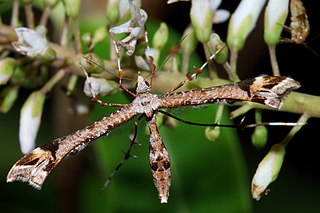
Drepaninae are by far the largest subfamily of the Drepanidae moths. While it is usually split into two tribes, Drepanini and Oretini, its internal systematics and phylogeny are not well resolved.
Hyalospectra is a genus of moths belonging to the subfamily Drepaninae.

Amblyptilia falcatalis, the common Hebe plume moth, is a species of moth of the family Pterophoridae. This species was first described by Francis Walker and is endemic to New Zealand. This species can be found in both the North and South Islands. The larval host plants are in the Veronica genus and include Veronica stricta,Veronica salicifolia,Veronica elliptica, Veronica macrocarpa and Veronica speciosa. This moth likely has two broods a year and adults have been observed all year round.
Canucha curvaria is a moth in the family Drepanidae. It was described by Francis Walker in 1866. It is found on Misool Island in New Guinea and on the Solomon Islands.
Pseuderosia humiliata is a moth in the family Drepanidae. It was described by Francis Walker in 1861. It is found on Borneo.
Hoplomorpha notatana is a moth in the family Oecophoridae. It was described by Francis Walker in 1863. It is found in Australia, where it has been recorded from Queensland.
Tonica citrantha is a moth in the family Depressariidae. It was described by Alexey Diakonoff in 1967. It is found on Luzon in the Philippines.
Dichomeris abscessella is a moth in the family Gelechiidae. It was described by Francis Walker in 1863. It is found in Guyana and Amazonas, Brazil.
Dichomeris hemichrysella is a moth in the family Gelechiidae. It was described by Francis Walker in 1863. It is found in Brazil (Amazonas), Guyana and Peru.
Dichomeris designatella is a moth in the family Gelechiidae. It was described by Francis Walker in 1864. It is found in Peru and Amazonas, Brazil.
Helcystogramma rusticella is a moth in the family Gelechiidae. It was described by Francis Walker in 1864. It is found in Amazonas, Brazil.
Hypatima corynetis is a species of moth in the family Gelechiidae. It was described by Edward Meyrick in 1913. It is found in Sri Lanka.
Hypatima mancipata is a moth in the family Gelechiidae. It was described by Edward Meyrick in 1913. It is found in Mpumalanga, South Africa.
Hypatima agriogramma is a moth in the family Gelechiidae. It was described by Edward Meyrick in 1926. It is found on Borneo.
Anarsia austerodes is a moth in the family Gelechiidae. It was described by Edward Meyrick in 1918. It is found in Namibia and South Africa.
Pessograptis cancellata is a moth in the family Gelechiidae. It was described by Edward Meyrick in 1914. It is found in Guyana.
Antaeotricha aratella is a moth in the family Depressariidae. It was described by Francis Walker in 1864. It is found in Amazonas, Brazil.
Antaeotricha basirubrella is a moth in the family Depressariidae. It was described by Francis Walker in 1864. It is found in Amazonas, Brazil.
Antaeotricha umbratella is a moth in the family Depressariidae. It was described by Francis Walker in 1864. It is found in Brazil (Amazonas), Panama, Costa Rica, Guyana and French Guiana.
Megalopyge defoliata is a moth of the Megalopygidae family. It was described by Francis Walker in 1855. It is found in Mexico.

